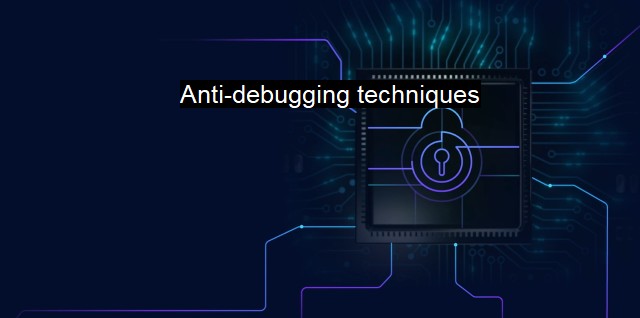What are Anti-debugging techniques?
Unmasking the Shadowed Strategies: An Overview of Anti-Debugging Techniques Employed by Malicious Actors
Anti-debugging techniques are tactics used to evade, obstruct or mislead debugging efforts to scrutinize malicious activities or operations within a computer system. These techniques are commonly used in shrouding malware and other intrusive software from being inspected, analyzed, and removed by antivirus or anti-malware tools. While debugging is an essential part of cybersecurity, permitting code inspections and making system vulnerabilities visible, the misuse of this technique by cybercriminals results in advanced, hard-to-detect threats being launched against computer systems.The purpose of anti-debugging is to avoid and derail the forensic activities of researchers, developers, and cybersecurity analysts. This is achieved by implementing tactics that deter or confuse the debugger, disabling it from decoding the actual purpose and actions of a running program. Anti-debugging techniques evade cybersecurity efforts to safeguard systems, preserve data privacy and maintain operations.
There are various types of anti-debugging techniques that threat actors employ to guard their rogue code. Some techniques implement time checks or induce program crashes during debugging, drawing attention away from the real actions involved. For instance, a malware code could be designed to crash during debugging, thus hindering system analysis and incident response.
In several cases, anti-debugging techniques involve the so-called 'spaghetti code.' Here, the execution path within the system appears disorganized and incredibly difficult to predict. The code may contain many jumps and cross-references that confuse anyone trying to follow program paths, essentially clouding the malware's activity and intentions.
With the use of API functions, malware can also implement an anti-debugging strategy. Some APIs return different system statuses depending on whether the system is in debugging or not. Calling these APIs, a malware program can identify when a debugging tool is active and alter its behavior to evade detection.
In some more advanced techniques, malware uses code obfuscation to hide its actual content and intent. This evolves into polymorphic or metamorphic malware—these can rewrite or modify their code to evade signature-based detection. In fact, polymorphism and metamorphism are technically a higher evolution of simple anti-debugging techniques as they involve sophisticated coding to generate reconfigured versions of the original malware.
It's important to understand that anti-debugging techniques mainly act as debris, flinging in the face of defenders trying to decode the encrypted contents. They thrive on extending the time required to comprehensively analyze a piece of malware, which puts more systems at risk as analysts and tools struggle to keep up.
Addressing these anti-debugging techniques requires sophisticated and effective security measures. Debuggers need to be consistently modified or updated to overcome the rogue codes. Conventionally, this involves static analysis, dynamic analysis, and signature-based heuristics. More recently, the use of machine learning and AI within cybersecurity is also polling as an effective tool for dealing with advanced malware employing anti-debugging measures.
Anti-debugging poses a multitude of challenges in the field of cybersecurity. While they are sophisticated and elusive, understanding these techniques is an essential step when combatting malware. Constant vigilance through system updates, regular debugging, and employing advanced analytical measures to scan codes seems rightfully fit as the primary approach to battling these techniques. Therefore, realizing these anti-debugging techniques are out there and being prepared is a fundamental aspect of maintaining and improving cybersecurity.

Anti-debugging techniques FAQs
What are anti-debugging techniques?
Anti-debugging techniques are cybersecurity measures used to prevent the analysis of software programs by reverse engineers, hackers, or antivirus software. These techniques make it challenging to identify bugs, vulnerabilities, or other malicious code injected into the program.Why are anti-debugging techniques important for cybersecurity?
Anti-debugging techniques are essential for cybersecurity because they prevent malicious actors from analyzing software programs and identifying vulnerabilities that can be exploited. By thwarting reverse engineering, hackers cannot easily detect the security controls in place, making it more challenging to exploit the system.What are some common anti-debugging techniques used by malware developers?
Some common anti-debugging techniques employed by malware developers include code obfuscation, runtime checks, process detection, encryption, and self-modifying code. These techniques can make it difficult for security professionals to analyze the code and identify potential threats.How do antivirus software vendors counteract anti-debugging techniques?
Antivirus software vendors counteract anti-debugging techniques by using various countermeasures such as emulation, sandboxing, dynamic analysis, and behavior analysis. These techniques enable antivirus software to identify the malicious behavior of the program without executing it directly, thus bypassing the anti-debugging tactics used by malware.| | A | | | B | | | C | | | D | | | E | | | F | | | G | | | H | | | I | | | J | | | K | | | L | | | M | |
| | N | | | O | | | P | | | Q | | | R | | | S | | | T | | | U | | | V | | | W | | | X | | | Y | | | Z | |
| | 1 | | | 2 | | | 3 | | | 4 | | | 7 | | | 8 | | |||||||